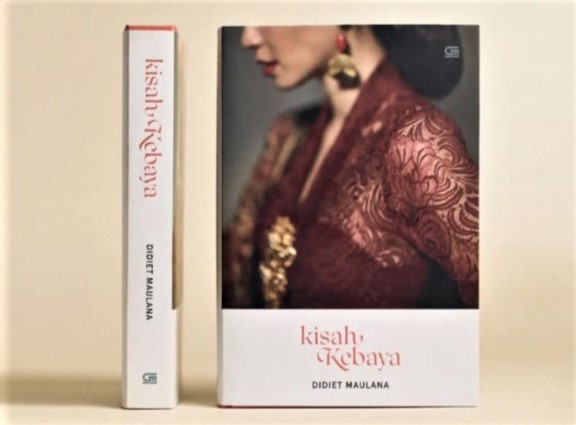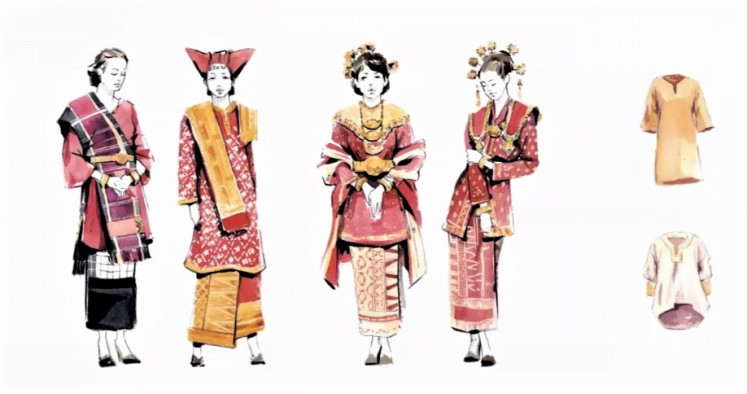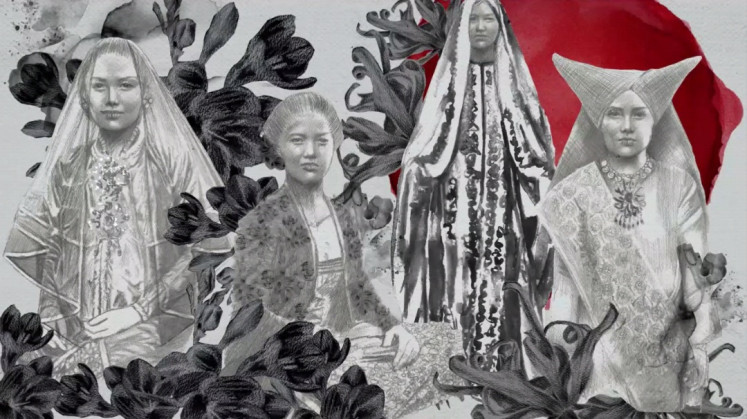Popular Reads
Top Results
Can't find what you're looking for?
View all search resultsPopular Reads
Top Results
Can't find what you're looking for?
View all search results‘Kisah Kebaya’: Labor of love on Indonesia’s sartorial icon
The 340-page book offers A-to-Z knowledge about Indonesia’s traditional tunic-like blouse, including tips on how to make them at home.
Change text size
Gift Premium Articles
to Anyone
Kebaya is a fashion icon of Southeast Asia that has its roots in the Indonesian island of Java.
The earliest form of kebaya is believed to have its origins in the 15th century royal courts of the Majapahit Kingdom, although it also appears in the bas-reliefs of the Borobudur Temple.
It has various names in local tongues, but the word “kebaya” is believed to derive from the Portuguese loanword “cabaya” around the time European traders arrived in the archipelago.
Some argue that the word could originate from the Arabic “qaba” meaning clothing or even “abaya” for loose outer garment, citing the emerging influence of Islam around the late 13th century.
Others fixate on the Chinese influence in the recognizable features of kebaya: a fitted tailored blouse that opens at the front with a lapelled, collarless neckline.
Regardless, this garment is uniquely Indonesian and has regional variations that each deserves their own chapter.
How-to tips: A hand-drawn illustration in 'Kisah Kebaya' presents regional variations of kebaya from across the archipelago. (Courtesy Kisah Kebaya/Didiet Maulana)The newly launched Kisah Kebaya (The Story of Kebaya) provides complete, in-depth information about the garment, including the many theories on its origins, possible cultural influences and its political, social and economic impacts from the past to the present day.
The book compiles more than six years of research by fashion designer and entrepreneur Didiet Maulana, which was prompted in 2012 when he first came across documentation on kebaya as he started exploring the garment’s characteristics and how to make it.
“It’s a waste to [keep] such information just to myself. The more people know about it, the more they will appreciate kebaya,” the founder and creative director of IKAT Indonesia said at the virtual book launch on Jan. 18.
Didiet also sought more references at weathered bookshops in many cities and found a dog-eared volume about kebaya at a vintage store in Tokyo. He also interviewed kebaya makers on his trips across the country.
The resulting book is certain to come in handy for those interested in the garment’s history, as well as those who wishing to develop their skills in kebaya “etiquette”.
One section of the book contains sewing patterns for several kebaya variations. It comes with a complete guide that covers everything from the fitting process to the best materials for different occasions, and from how to wear it with kain (a kind of sarong) to the best accessories for completing the look.
It even has a color wheel for combining prints and patterns for an attractive effect.
“It can be a handbook for those looking for the right materials for kebaya and trying to wear kebaya, as well as for [hobby] dressmakers to start making their own. Kebaya is our heritage, so the ability to make it should not rest solely in the hand of designers,” said Didiet.
Fashion heritage: An illustration of a painting in Didiet Maulana’s 'Kisah Kebaya' depicts several regional variations of kebaya worn by Indonesian women in the past century. (Courtesy Kisah Kebaya/Didiet Maulana)Kisah Kebaya, which took one-and-a-half years to finish writing, also contains personal stories and anecdotes from several public figures about their families’ kebaya culture. The book also features the collections of IKAT Indonesia’s couture line, SVARNA.
The softcover book is available for Rp 268,000 (US$19) at bookstores from Feb. 24, while pre-orders will receive a 10 percent discount until Jan. 31.
“Kisah Kebaya is not the first reference book on kebaya, but it is based on research and has credible references that make it easy for us on the editorial team to verify them,” said editor Nana Lystiani of Gramedia Pustaka Utama.
She added that the publisher was also running a fundraiser for distributing Kisah Kebaya to vocational schools in the country that offered fashion majors, with all donors to receive an autographed copy. (ste)













